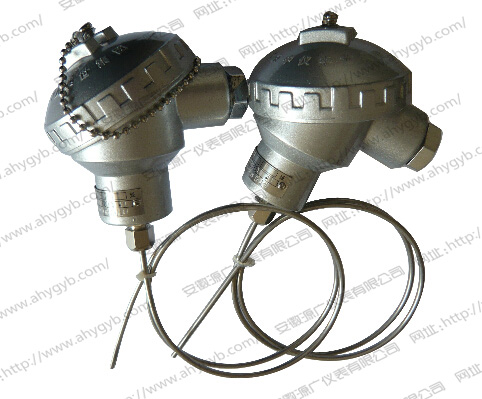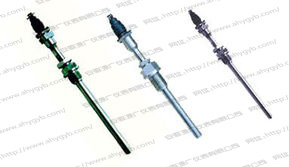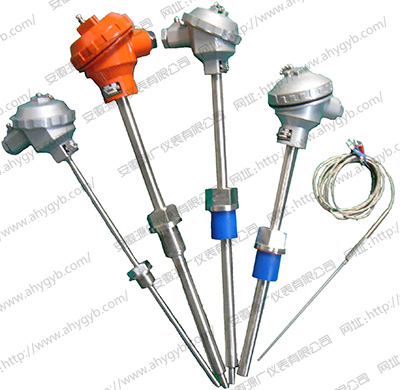Add to cart success!
Product Introduction:
Thermal resistance is the most common temperature detector in the middle and low temperature zone. Its main features are high accuracy, performance stability. Platinum thermal resistance of the measurement accuracy is the highest, it is not only widely used in industrial temperature measurement, but also be made into standard reference.
Is different from the principle of thermocouple temperature measurement and thermal resistance is based on the resistance of thermal effect of temperature measurement, the resistance value of the resistor body changes with the temperature and the changes in the characteristics. Therefore, as long as the measurement of resistance changes a sense of warm resistance, it can measure the temperature. At present, there are two kinds of metal thermal resistance and semiconductor thermistor.
The resistance value and temperature of the metal thermal resistance can be expressed in the following approximate formula.
Rt=Rt0[1+ (t-t0)]
In the formula, Rt temperature T value; Rt0 temperature t0 (usually t0=0 C) when the corresponding resistance value; a temperature coefficient.
The semiconductor thermistor resistance and temperature relationship
Rt=AeB/t
Where Rt is the temperature of T resistance; constant A, B depends on the structure of semiconductor materials.
Phase comparison, the thermistor temperature coefficient is larger, the room temperature resistance values high (usually over thousands of Europe), but a bad interchangeability, serious nonlinear, temperature range only -50~300 DEG C and a lot for cars, appliances and temperature detection and control. Metal thermal resistance is generally applied to the temperature measurement in the range of -200~500, which is characterized by accurate measurement, good stability, reliable performance and wide application in the process control.
Thermal resistance material
Thermal resistance temperature measurement is based on the value of the resistance of the metal conductor with the increase of temperature and the increase of the characteristics of temperature measurement. Thermal resistance are made of pure metal materials, the application is currently the largest platinum and copper, in addition, now has begun to use nickel, manganese and rhodium, and other materials to make thermal resistance.
Thermal resistance type
(1) the structure and characteristics of the thermal resistance temperature sensor (resistance) of the industry commonly used in the industry. From the thermal resistance temperature measurement principle knowable, the measured temperature is directly through the thermal resistance resistance to measure the changes. Therefore, the thermal resistance of the leads to wire and other wire resistance change will bring influence to the temperature measurement. In order to eliminate the influence of wire resistance, the same as the use of the three wire or four wire system.
(2) armored thermal resistance: armored thermal resistance is temperature components (resistors), a lead wire, insulation materials, stainless steel casing and solid body by a sense of, its diameter is Phi 2 ~ Phi 8mm, up to a minimum diameter of mm. It has the following advantages compared with the conventional thermal resistance:
Small volume, no air gap, thermal inertia, the measurement of the lag is small;
Good mechanical properties, resistance to vibration, impact resistance;
Can bend, easy to install;
The long service life.
(3) thermal resistance of the end surface of the end surface of the thermal resistance of the end surface of the thermal resistance temperature sensor by the special treatment of resistance wire material, close to the end of the thermometer. Compared with the general axial thermal resistance, can correctly and quickly reflect the actual temperature of surface to be measured, applicable to the temperature of the measurement of bearing and other parts of the face.
(4) the insulation type of thermal resistance: the insulation type of thermal resistance through the special structure of the junction box, the internal explosive mixed gas in the case of a spark or electric arc and other effects of the explosion limits in the junction box, the production site will not lead to explosive. The thermal resistance can be used in the temperature measurement of the explosive dangerous places in the Bla~B3c class.
Common metal thermal resistance in industry
From resistance with temperature changes, most of the metal conductor has this property, but not can be used as a resistance temperature detector, a thermal resistance of metal materials general requirements: as large as possible and stable temperature coefficient, electrical resistivity to (in the same sensitivity reducing device size), in the temperature range with stable physical and chemical properties, the material of good copy, resistance varies with temperature to a value function (preferably in the form of a linear relationship).
At present, the most widely used heat resistance material is platinum and copper: platinum resistance, high accuracy, suitable for neutral and oxidizing medium, good stability, with a certain degree of nonlinearity, the higher the temperature is, the higher the resistance change rate is. China's most commonly used R0=10, R0=100 and R0=1000, etc., their graduation numbers are Pt10, Pt1000, Pt100; copper resistance has R0=50 and R0=100 two kinds, they are Cu50 and Cu100. Among the most widely used Pt100 and Cu50.
Signal connection mode of thermal resistance
The thermal resistance is a component of the change in temperature, which is usually required to pass the resistance signal to a computer control device or other instrument. Industrial thermal resistance is installed in the production site, there is a certain distance between the control room, so the thermal resistance of the lead wire to the measurement results will have a greater impact.
There are three main ways of thermal resistance.
101 1 two-wire system: at both ends of the thermal resistance of the connecting a wire to elicit resistance signal called two-wire system: this wire method is very simple, but due to the connecting wires must exist lead resistance R and R size and wire materials and the length of the factors, so the square leads to apply only to lower the measurement accuracy in occasions
Second, three wire system: at one end of the thermal resistance of the root of the connected a piece of lead, and the other end is connected with two leads the way called for three wire system, this way is usually associated with bridge supporting the use, can better eliminate the effect of lead resistance, is in the industrial process control is the most commonly used lead resistance.
Third, four wire: on the both ends of the thermal resistance of the root each connection two wires called for four wire, which two leads to thermal resistance provides a constant current, I, R is converted into voltage signal U, through the other two wires to u lead to secondary instrument. Can be seen that this lead can completely eliminate the resistance of the lead, mainly for high precision temperature detection.
Thermal resistance using three wire method. The three wire system is used to eliminate the error caused by the resistance of the connecting wire. This is because the measurement of the thermal resistance of the circuit is generally not balanced bridge. As a bridge arm resistance, the thermal resistance of the bridge is a part of the resistance of the bridge arm, which is unknown and is caused by the environmental temperature. Using three wire system, will lead a wire to the power supply side, and the remaining two were received from the thermal resistance of the bridge arm and its adjacent bridge arm, which eliminates the wire resistance caused by the measurement error. Industry generally uses three wire method. The thermocouple is a millivolt signal, this problem does not exist.
Composition of thermal resistance temperature measurement system
(1) the thermal resistance temperature measurement system is composed of the thermal resistance, the connecting wire and the display instrument. Must pay attention to the following two points:
The thermal resistance and the index number of the display instrument must be the same.
In order to eliminate the influence of the change of the resistance of the connecting wire, three wire method must be adopted. See the third chapter of this article.
(2) armoured thermal resistance sheathed thermal resistance temperature components (resistors), a lead wire, insulation materials, stainless steel casing and solid body by a sense of, its diameter is Phi 2 ~ Phi 8mm, up to a minimum diameter of mm. It has the following advantages compared with the conventional thermal resistance:
Small volume, no air gap, thermal inertia, the measurement of the lag is small;
Good mechanical properties, resistance to vibration, impact resistance;
Can bend, easy to install
The long service life.
(3) the thermal resistance of the end surface of the end surface of the thermal resistance of the end surface of the thermal resistance temperature element is wound by a special treatment of the resistance wire material, which is close to the end of the thermometer. Compared with the general axial thermal resistance, can correctly and quickly reflect the actual temperature of surface to be measured, applicable to the temperature of the measurement of bearing and other parts of the face.
(4) the insulation resistance of the thermal resistance by the special structure of the junction box, the outer shell of the internal explosive mixed gas due to the impact of the spark or electric arc welding repair is bound to change the length of resistance wire and affect the resistance, so the new resistance is replaced, if the use of welding, welding to verify the use of qualified.
Difference between thermocouple and thermal resistance
Thermocouple and thermal resistance are in the temperature measurement of contact type temperature measurement, although the role of the same is the measurement of the temperature, but their principles and characteristics are not the same.
First, introduce the thermocouple, thermocouple is the most widely used in temperature measurement of the temperature of the device, his main feature is a wide temperature range, performance is relatively stable, and has the advantages of simple structure, good dynamic response, better able to remote 4-20mA, convenient automatic control and centralized control. Thermocouple temperature measurement principle is based on thermoelectric effect. The two different conductor or semiconductor are connected to form a closed loop, when the two junction temperature and loop will produce heat potential, this phenomenon called thermoelectric effect, also known as the Seebeck effect
Related products:















